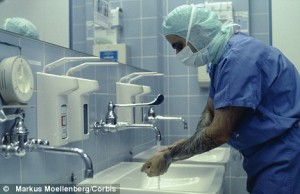Doctors are more cautious under the eye of a camera
Thursday, December 1st, 2011 8:09:30 by Fahad Awan
Doctors are more cautious under the eye of a camera
A new study found that more doctors and nurses washed their hands when video cameras were installed in every room in their unit and the staff was continuously informed about rates of hand-washing compliance.
While the hand-washing turnaround was "pretty amazing," one of the study’s authors said, it’s unclear whether the measure helped achieve the ultimate goal — preventing infection transmission in the hospital — and whether it would be cost-effective in other
settings.
"Hand washing is an integral part of infection control," said Dr. Bruce Farber, from North Shore University Hospital in Manhasset, New York. But, "rates of hand washing among health care workers are less than perfect."
Cameras and timely feedback seem to be a strategy that can address that, he told Reuters Health. "It’s certainly one tool that can be used. I certainly don’t think it’s ever going to be used by everyone, everywhere."
Farber and his colleagues conducted the new study in their intensive care unit between 2008 and 2010. They installed $50,000 worth of cameras in hallways and patient rooms — pointing at every sink and hand sanitizer dispenser — as well as motion sensors in
all doorways.
Off-site reviewers monitored those videos and checked whether any doctor or nurse who came through a patient’s door washed their hands within ten seconds, and if they did the same on the way out. Doing that earned workers a "pass," while waiting too long to
wash up or not doing it at all counted as a "fail."
Then, the system sent compliance rates by room to electronic boards in the ward’s hallways and to supervisors, so all staff could see how well they were doing as a unit.
Before health workers started getting that constant feedback, less than seven percent of them washed their hands immediately when entering or before leaving a patient’s room, according to video records.
That shot up to 82 percent in the weeks after the hallway messages started, and reached an average high of 88 percent over the next year and half of monitoring.
Tags: Cameras, doctorsShort URL: https://www.newspakistan.pk/?p=5316

















